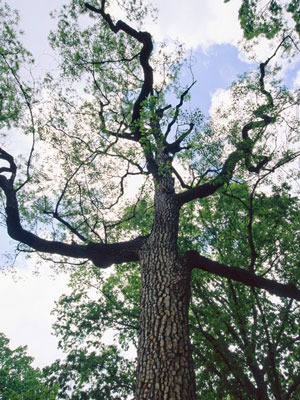The Persimmons are flowering
2007 May 17
By Ken Moore
Flora Columnist
“Wow, how about that Persimmon flower!â€
“I don’t see any flower!â€
“There it is, right there in that little angle, where the leaf is attached to the stem.â€
“All I see is a little green thing!â€
“Yeah; that’s it! A tiny little green flower. How many tiny little green flowers do you ever get to see? Is that cool, or what!!!â€
I was so excited years ago to discover my first Persimmon flower. Well, it isn’t one of those neon knock-your-socks-off floral experiences unless you get excited about little green flowers, think they’re beautiful, and especially hope to be gathering tasty ripe Persimmons following fall’s first really hard frost.
The Persimmon (Diospyros virginiana) is a special tree. “Usually pronounced ‘simmon. Often called ‘possum apple.’ A popular wild fruit in the Cape Fear River Valley. A liquid concoction from the inner bark of the tree is supposed to be one of the best gargles for ulcerated or sore throats.â€
So goes part of the description of the Persimmon from Paul Green’s Plant Book, published in late 2005 by the North Carolina Botanical Garden Foundation. Beyond his better known writings, Green kept lifelong notes on the cultural and natural history of his Cape Fear River Valley homeland, including Carrboro and Chapel Hill. His many notes and observations on how local folks appreciated and depended upon the local flora were extracted from the two-volume Paul Green’s Wordbook to produce the Plant Book, beautifully illustrated with the color photographs of one of his daughters, Betsy Green Moyer. Included is a full description of the preparation of Persimmon beer, about which Green concluded: “Man never could drink enough to get drunk on it, and now that legitimate beer has come in, making of persimmon beer has just about passed out.â€
Today many local folks still cherish the fall tradition of collecting ripe Persimmons for Persimmon pudding and bread. Taste a green or less than fully ripe one and you’ll never forget that mouth-puckering experience. My preferred Persimmon treat is very simple. I extract the seed and use the sweet cinnamon-colored pulp directly as a sauce for vanilla ice cream. Persimmon lovers will keep the locations of their favorite female trees a secret because the possums and other wild critters are more than enough competition for these tasty treats. Trust me, Persimmons are best when the freshly fallen fruit are quickly plucked from the ground.
There are some mighty Persimmon trees scattered about our community. Don’t expect me to tell you exactly where they are, because I am one of those avid fall Persimmon pickers. I will mention that one of them is a stately female specimen in full view of a bus stop, and it is such a prolific producer of delicious fruit that, if you are observant enough to discover it, I’m happy to share it.
There is a 200-plus-year-old specimen on the Polk Place quad on the UNC campus. Its odd position on the edge of the green, out from the double row of oaks planted in the 1930s, indicates that it was a part of the original forest cleared south of South Building to make way for university expansion.
Decades ago the local folk had great appreciation for the old ‘simmons and left them standing in place when clearing land. The tree on Polk Place is a female, but don’t expect to find many Persimmons; most of the former adjoining forest has long since been cleared, and I fear the lone male or two left standing are too far distant for insect pollinators to travel. It is, however, well worth a stroll on campus to see that tree, which, though not as large as the sacred Davie Poplar located north of South Building, is memorably impressive. When standing under that grand old Persimmon tree, observe the characteristic dark chinky bark, look straight up at the real character of the tree and then step up and hug it. Haven’t you ever hugged a tree? It will take at least two to hug this tree, and it’s worth it.
Go ahead, no one’s looking; it’s OK to hug the tree. And then you’ll know how to identify a tree for your own ‘simmon picking, come next fall.
Email Ken Moore at flora@carrborocitizen.com.



Comments are closed.